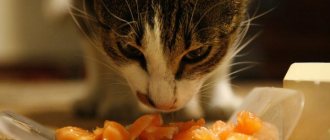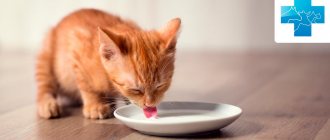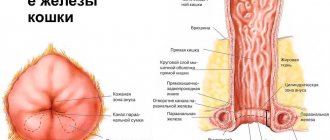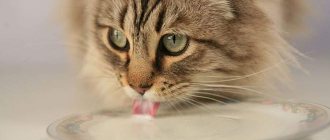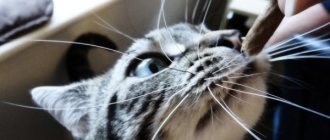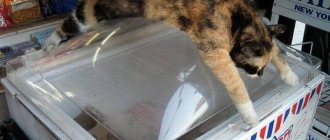Cats and chocolate - why do we say no to candy?
Common phrase: “In the end, a cat always knows what is good for it and what can harm it.” Could this be true? Why should we stop a cat from eating chocolate?
Cats have a very specific metabolism. Many foods that people eat almost every day are hazardous to their health for cats: nuts, raisins, onions, avocados... These are just a few examples. Sweets also pose a serious threat - chocolate is extremely toxic. Unfortunately, not all owners know that by offering their cat some sweets, they risk serious health complications.
So, to the question:
Can cats eat chocolate? We answer: absolutely not!
Can cats eat chocolate?
NO! But why?
Read also: How to make an origami rose
Cocoa seeds contain many substances that are very dangerous to a cat's health. Methylxanthines: Theobromine, caffeine, and theophylline are plant alkaloids derived from xanthine. They are simply poisonous to cats (they are also found in tea leaves and mate, coffee beans and kola nuts - so tea, coffee and Coca-Cola are also excluded).
- Theobromine, like caffeine, makes the heart beat faster. This can lead to tremors, tachycardia and palpitations. It is also a strong diuretic, which is especially dangerous for cats - we know how quickly cats become dehydrated and the consequences of this. It also has antispasmodic properties - it relaxes smooth muscles and also dilates blood vessels. Stimulates the nervous system. Since animals, especially cats, have a much slower metabolism of this substance, it is extremely dangerous for them. Kittens have virtually zero tolerance to this alkaloid. Theobromine can be present in a cat's blood for up to 3 days after eating chocolate!
- Theophylline also dilates the bronchi and blood vessels, has a diuretic effect and relaxes the bile ducts.
- Eating sweets itself causes obesity and many other diseases that they cause (for example, kidney problems, liver problems, pancreatic insufficiency, diabetes). These risks should not be underestimated. There are more and more obese cats, and most of them suffer greatly from it.
- Eating sweets also poses a risk of tooth decay and serious periodontal disease.
Why do many animals prefer this dessert?
It is known that these furry predators usually eat meat, poultry and fish fillets. Today, some owners feed them with special foods that can be purchased at pet stores, but in addition give them a taste of food prepared for people. Owners have different answers to the question of what cats like. After all, animals often give preference to products that are atypical at first glance. For example, desserts containing cocoa bean powder. These are chocolate bars and bars, candies, cookies.
Do cats like sweets?
Fortunately, the cat's body has protected itself from toxic substances, and cats simply do not taste sweetness. Due to a defect in the Tas1r2 gene, cats do not have sweet receptors. And fortunately. However, sometimes their curiosity and boredom overcome nature. Therefore, as owners, we must ensure that the cat does not have access to sweets.
Keep in mind that not only is chocolate toxic, but so are the following foods:
- cocoa and products that contain it,
- ice cream - especially chocolate ice cream,
- chocolate pudding,
- chocolate candies,
- candies with cocoa and coffee filling,
- chocolate drinks and mousses,
- cake with cocoa mass and coffee,
- bars,
- chocolate yoghurts.
How to prevent poisoning
Cat poisoning from chocolate is very easy to prevent: you need to keep chocolate away from it. Cats are curious and unpredictable creatures that love to prowl around corners, including the kitchen. All chocolate should be stored in tightly closed containers. Not only chocolate can cause a reaction, but also foods that contain it, including cakes, donuts, cookies, candies, etc. If there is a party or holiday coming up, it is better to place plates with sweets in places that are difficult for the cat to reach and remove them immediately after the holiday. If a guest asks: “Can cats have chocolate?”, you need to answer decisively: “No!”
Owners love to reward their furry friends with treats, and now you can do it without risking your pet's health. The main thing is to choose the safest treats, created specifically to keep your cat healthy and in good spirits. And at the same time, all the chocolate will go to the owner!
The effect of dessert on the body of pets
Experts say that this sweetness does not bring any benefits to the cat’s health. However, some owners believe that sometimes you can pamper your pet with such food. Is dessert really safe? Veterinarians warn that they often encounter cases of intoxication that occurs due to substances contained in the product.
When does a cat need sugar?
But still, in some cases, the pet needs additional sugar. They are very rare and are the consequences of serious illness or recovery in the postoperative period. And only when the level of glucose in the blood is much lower than the norm acceptable for the cat’s body.
In no case does the owner of the animal have the right to make such an appointment if he does not want to cause irreparable harm to him. Only a veterinarian, after a thorough analysis, can decide on a special “sweet” diet.
But even in this case, cats are prohibited from chocolate, cakes, pastry buns, cookies and yoghurts, especially carbonated drinks. Surprisingly, many pets are very fond of Coca-Cola and Fanta, sweet tea.
What mistakes do we make when faced with hair loss?
Don't panic if you're losing hair
Everyone knows the close relationship between the process of hair loss and the state of the psycho-emotional background. After all, stress is a factor causing hair loss, and it can also delay hair loss caused by other factors. The prospect of future baldness is one of the main reasons contributing to the appearance of neurosis, especially in women who naturally have thick hair. The longer the loss lasts, the greater the fear of losing the “last” hair becomes and the emphasis on the fact of loss increases. It is necessary to understand that severe and sudden forms of hair loss are most often the most favorable, most often they have a clear connection with the previous fever, disease, medication, etc., and in most cases they even go away on their own.
Don't wash your hair rarely
Washing your hair is an important hair care measure, especially during periods of active hair loss. Limiting the frequency of washing, especially the fear of washing your hair, is undesirable not only from a psychological point of view, but also from a health point of view. Sebaceous secretions that accumulate on the surface of the head during infrequent washing can cause inflammation of the skin and aggravate hair loss. On the contrary, trichologists recommend intensifying skin cleansing during periods of active hair loss - using active medical shampoos that regulate oiliness, peelings, and exfoliants.
You can’t limit combing your hair or “accumulate” falling hair.
The hair loss stage lasts 3 months - this is the period from the cessation of hair growth until the moment the hair leaves the scalp. If the hair is not combed out on time, then the dead hair will mechanically prevent the growth of “new” hair growing in its place.
You can't be in the sun without a hat
The role of negative influence of ultraviolet radiation on hair loss has been proven. The more intense the loss, the thinner the hair becomes, the greater the progression of the hair loss process.
Lost hair should not be collected or counted.
According to statistics from trichologists, collecting and counting hair that has left the head has only a negative effect on the course of hair loss. Collecting hair helps women focus on the process of hair loss, makes them neurotic, and in no case allows them to understand how much hair loss exceeds the daily norm.
Do not rub oils into the scalp
The scalp is an area with very high sebum secretion. Additional application of fatty products, especially oils that have a comedogenic effect, can contribute to the appearance of inflammation, dandruff and skin soreness and aggravate hair loss.
You can’t be on a low-calorie, low-protein diet.
Hair follicle cells are one of the most rapidly dividing cells in the human body, which is why they require a large amount of energy for normal metabolism. It is believed that a caloric intake of less than 1200 kcal can lead to hair loss. As for protein, this is the main structural element of the hair shaft (keratin protein), so all essential amino acids must be present in the diet.
Oral contraceptives cannot be stopped
Many of the existing oral contraceptives have a positive effect on hair growth because they contain female hormones estrogen, and in some cases they reduce male hormones. Follicle medications are not advisable at the time of hair loss, when the hair cells are already too sensitive to all unfavorable factors.
Hair should not be treated with immunostimulants and anthelmintic drugs.
In the old fashioned way, some doctors associate hair loss with reduced immunity or helminthic infestation, prescribing appropriate medications to “treat” hair loss. In fact, most immunostimulants and anthelmintic drugs, on the contrary, are the “culprits” of hair loss.
You cannot start or stop medications containing minoxidil on your own.
Minoxidil is the only topical drug that has a high degree of effectiveness in hair thinning. In Russia, it is freely available and is often used independently, on the recommendation of a pharmacist or consultant on the Internet. However, minoxidil is a drug for chronic use, which has a “withdrawal syndrome”, can cause unwanted effects and gives enhancements at the beginning of use. That is why in acute, benign forms of loss, and in diffuse loss, it can only do harm.
Don't despair when faced with hair loss. Most often, this is a temporary phenomenon that will not bring irreparable consequences. Remember that if hair loss continues for up to 3 months, hair leaves the entire surface of the head - this is acute hair loss, which, with proper care, will even go away on its own.
Source
Sweets and cat diseases
The first thing that can happen to a pet when eating sweets is a decrease in immunity and the development of many serious diseases.
Urolithiasis disease
Cats' kidneys are the first to suffer when they eat sweets. Due to intensive work (after all, this is a purification system that unsuccessfully tries to remove harmful products from the body), they significantly increase in size.
The animal's organs are subject to wear and tear, and the acid-base balance is disturbed. And sweets can lead to this just as much as salty foods.
Depending on the type of sweets, either excessive oxidation or alkalization of the body occurs, which in any case leads to the development of kidney failure. Urolithiasis, when eating sweets in large quantities, occurs even in cats that do not have a predisposition to it.
Diabetes
A cat's body is not designed to process large amounts of glucose. Insulin begins to be produced in concentrations that greatly exceed the permissible norm in the blood.
The cat quickly loses sensitivity to this substance, the level of glucose in both the blood and the animal’s urine always remains at high levels, diabetes mellitus quickly develops and the pet becomes a hostage to the “sugar” diet.
Excess carbohydrates
A person often eats a piece of chocolate when he needs to quickly increase energy levels, relieve fatigue, improve the ability to think and make decisions instantly, during heavy mental or physical work. And after even a small dose of chocolate, you feel a surge of strength and acceleration of thought.
By offering the same piece of treat to a pet, the owner causes him great harm. Especially for a cat in a small apartment, where she does not have the opportunity to move enough. All excess carbohydrates, even if they do not lead to serious illnesses, will certainly be stored in the form of excess fat.
Nature provides for the consumption of large quantities of proteins by predators, which is the key to their health and longevity. Carbohydrates are needed in minimal quantities; exceeding the required level means dooming your pet to illness and early death.
Chocolate and its effect on the cat's body
Some cats are true gourmets and show a special love for chocolate, but you shouldn’t be touched by it. Chocolate is extremely dangerous for the health of cats, not only because of the sugar. As you know, cocoa contains theobromine alkaloid, which is pure poison for cats. After eating a small amount of chocolate, the animal’s blood pressure will certainly increase, it will be active and overexcited, and arrhythmia may develop.
If you continue to periodically treat your pet to cocoa-containing products, he will develop heart and nervous system diseases, and a serious allergy is possible.
Large doses will definitely lead to coma and death. Kittens and cats with weakened immune systems are especially vulnerable.
Important: chocolate in any quantity is extremely dangerous and can cause the death of an animal! If a cat has eaten a lot of sweets or chocolate, it should be shown to a veterinarian.
The critical dose of theobromine, of course, varies from person to person, but on average it is 200 mg per 1 kg of animal weight.
Milk chocolate contains theobromine in an amount of 220 mg per 100 g of product. In black - twice as much.
Now let's figure it all out!
Let's start with the fact that cats do not taste sweets by definition.
They simply cannot -
they lack sweet taste receptors
=> they not only cannot taste the taste of sugar, but even the taste of its substitutes.
That is, the animal is attracted not by the sweet taste, but by the smell
(or consistency) of the product
You may also like the taste of oils added to foods, but not sugar.
Yes, arguments like “my cat loves sugar, I don’t understand why so many people say it’s not allowed” don’t work. You can't love what you can't feel.
Let's return to sugar and the second point, which follows from the first.
Due to the fact that the cat does not sense sugar, it is able to consume it uncontrollably.
It’s like with household gas - if special odorous impurities weren’t added to it, people wouldn’t even realize that they forgot to close the valve on the stove and would die from poisoning.
How much chocolate is too much
For a fluffy beauty, any amount of chocolate is too much; cats are not allowed chocolate. All forms of sweet treats are dangerous for your furry friend, including dry cocoa powder and baking chocolate, which is most toxic due to its high levels of theobromine. Dark, semi-sweet and milk chocolate and even white chocolate with its low cocoa percentage are also prohibited.
The level of toxicity depends on exactly how much chocolate the cat ate and what type it was. Petful notes that for a 5-pound cat, one small piece of dark chocolate can be as harmful as twenty-three chocolates to a human. Is chocolate bad for a cat? Yes, even in small quantities. She can get sick even if she eats just a little.
Signs of intoxication
Not all owners adhere to such rules. Veterinarians say that they often encounter intoxication that occurs after eating chocolate. Poisoning in cats associated with the consumption of this dessert most often occurs on holidays, when the owners have a large amount of candy on their table. How does the pathology manifest itself? Intoxication can be diagnosed if the following signs are present:
- Lethargy or increased anxiety.
- Strong feeling of thirst.
- Seizures.
- Vomiting.
- Frequent urination.
- Loose stools.
- Heart rhythm disturbances.
- Trembling in the muscles.
- Frequent breathing.
- Increased blood pressure.
- Coma.
Only a specialist can diagnose and treat the disease. Therefore, if the owner suspects that the pet has been poisoned by chocolate, he should take the pet to the veterinarian as soon as possible. You should tell the doctor how much dessert the cat ate. Sometimes the doctor advises to alleviate the animal’s condition by gastric lavage. For this, water mixed with crushed activated carbon is used.
Of course, all owners know what the cats living in their home love. However, before pampering your pet with any treat, you need to find out whether this food is as safe as it seems at first glance. Particular attention should be paid to the health of pregnant and lactating animals. The body of older animals and young animals is also sensitive.
The answer to the question of whether cats can have chocolate is very ambiguous. It all depends on the amount of dessert, the frequency of its use and the characteristics of the pet.
About the rules
It would be right if, before getting a pet, you study the future diet and the question of whether cats can eat chocolate.
It is important, when treating your cat with a chocolate treat, to follow some rules that will help protect the animal:
- You cannot accustom him to frequent treats, since the cat’s digestive tract takes a long time to digest this product.
- Before giving your pet a treat, you should think about whether cats can eat chocolate and calculate its permissible amount, knowing that 25 - 30 g of treats is considered a dangerous dose for an adult cat.
- Keep in mind that it will be safer to divide the amount of acceptable chocolate into several doses.
- Be sure to make sure your cat has enough to drink on sweet days.
Attention! You cannot increase the norm, since the cat eats chocolate without understanding the taste, and overeating can put it in mortal danger.
The effect of chocolate on cat health
Surely many cat owners have at least once noticed an increased craving for chocolate in their cats. Indeed, many animals love sweets very much . But few people know exactly how chocolate affects the body of cats. Statistics show that the largest number of poisonings are directly related to substances harmful to furry pets contained in chocolate. These substances include caffeine, methylxanthine, and theobromine. Their use threatens the animal with dehydration, an increase in the frequency of contractions of the heart muscles, a negative effect on the nervous system, as well as problems with the gastrointestinal tract.
Excessive use of hazardous substances can lead to death.
The most dangerous for cats are dark chocolate and chocolate bars made from grated cocoa . Milk chocolate also contains a large amount of harmful substances, but it is still safer for the cat’s health, but white chocolate is considered the most harmless.
What are the clinical signs of chocolate toxicity in cats?
Clinical signs usually appear within 6–12 hours after ingestion and may persist for up to three days in severe cases.
A cat may have the following clinical signs:
- Vomit
- Diarrhea
- Decreased appetite
- Increased thirst
- Frequent urination
- Increased heart rate
- Anxiety
- Shortness of breath or rapid breathing
- Muscle tremors
- Convulsions
- Coma
These symptoms can progress very quickly. Changes in heart rate and rhythm can lead to low blood pressure, while muscle tremors and spasms can lead to dangerously high body temperature.
If left untreated, these changes can be fatal.
Deadly danger
When a cat is poisoned by chocolate, the following symptoms appear:
Measures should be taken immediately, otherwise the cat’s liver may fail, which is fatal. The best way to help your pet is to call a veterinarian. Before his arrival, you can give your cat water with dissolved activated carbon to drink.
Important! Within an hour, provide the animal with medical assistance, which consists of gastric lavage and drinking plenty of fluids!
If more time has passed since the chocolate was consumed, then the cat will need inpatient medical care, where it will be connected to a ventilator, the functioning of the cardiac system will be monitored, and the level of intoxication will be monitored.
What sweets can a cat eat?
During the summer heat, many owners, showing false concern for their pet, give it ice cream. It seems that both the dairy product itself and cooling the body should only bring benefits. But in fact they do a lot of harm to the cat.
Ice cream for a cat, if necessary, can be easily made independently by freezing unsweetened natural yogurt, fermented baked milk or a mixture of cottage cheese and kefir. Almost all pets love these impromptu treats.
You can give cats a little corn and bell pepper, they have a sweetish taste. The sugar content in them is minimal, and there is a lot of healthy fiber. Almost all cats like these products.
It’s only better if the vegetables are boiled and the peppers are peeled. Under no circumstances should these products be consumed in canned form.
1111
Useful tips
Ice cream is a favorite treat for cats, especially in the summer season. But those products that are sold in the store cannot be given to pets due to their high sugar content. But you can make ice cream for your pet yourself, using only high-quality and natural ingredients without sugar.
Some owners are sure that nothing bad will happen to the animal from condensed milk. Actually this is not true. After eating this product, the cat may experience nausea, vomiting, diarrhea, loss of strength - all these are consequences of severe intoxication of the body.
If your cat is drawn to sweets and manages to steal them, then they need to be put in a place where the animal cannot get into.
To learn how sugar is harmful to cats, watch the following video.



